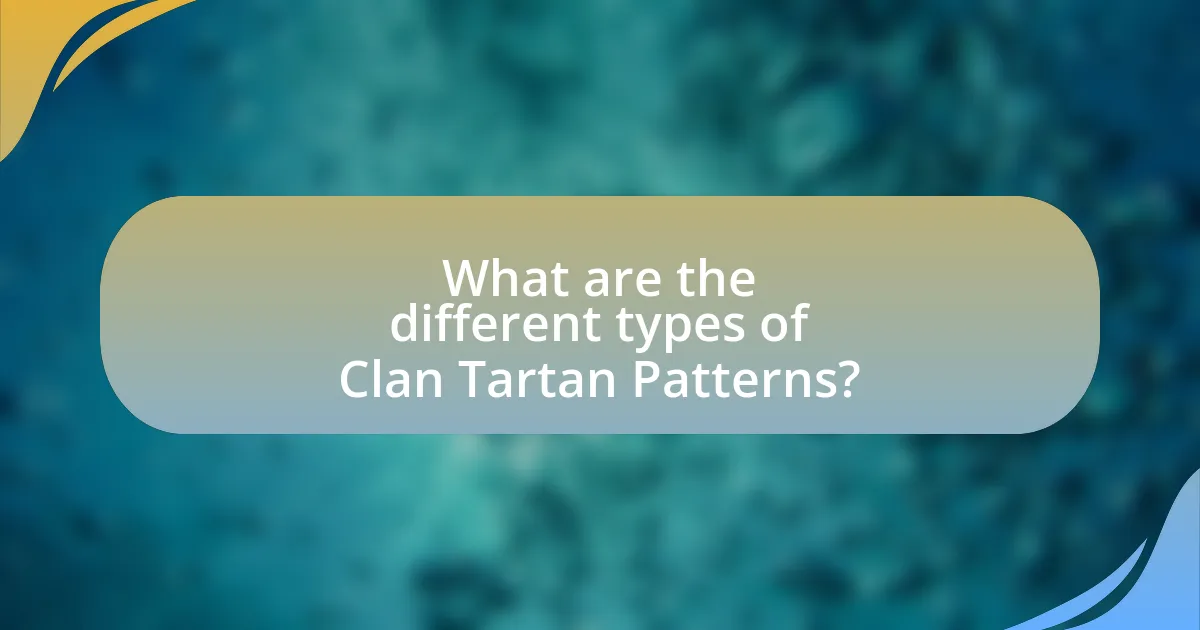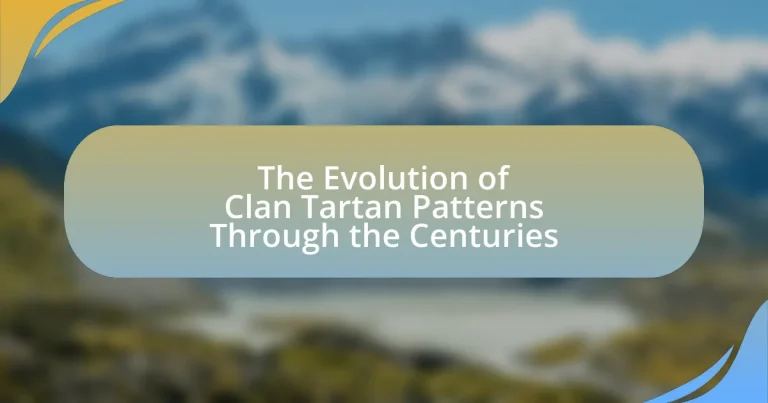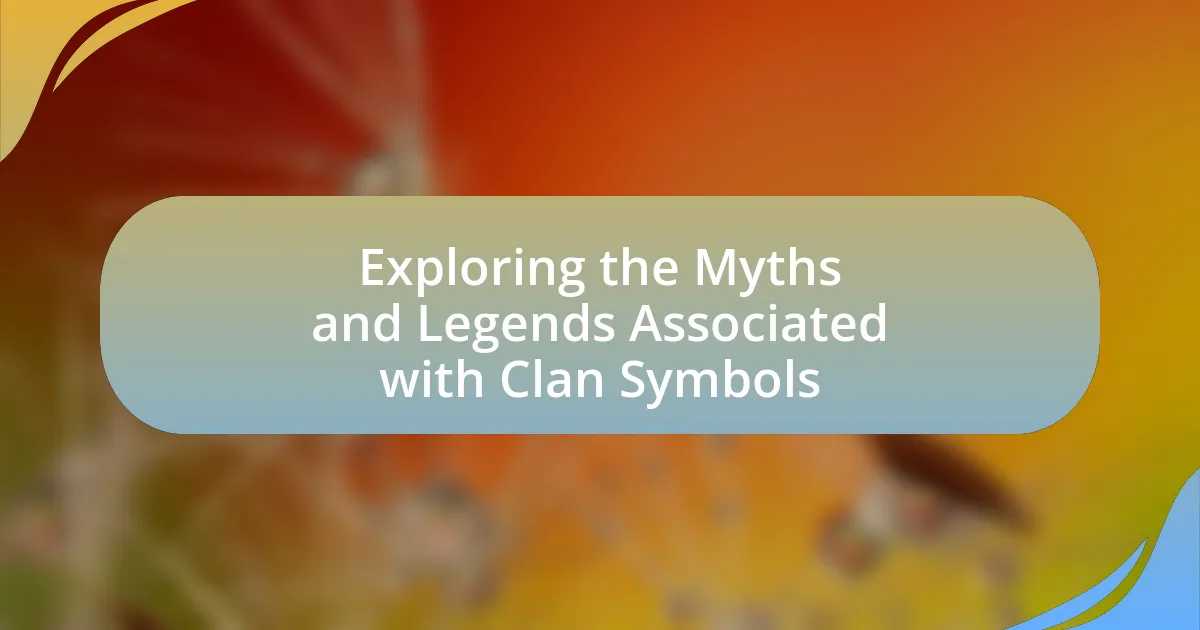Clan tartan patterns are unique textile designs linked to specific Scottish clans, characterized by distinct color combinations and geometric patterns. Historically, these patterns served as identifiers for clans, particularly during the 18th and 19th centuries, and became symbols of Scottish heritage. The article explores the origins of clan tartan patterns, their cultural significance, and how they evolved over time, influenced by historical events such as the Jacobite uprisings and the Industrial Revolution. It also examines the role of natural dyes, the categorization of tartans, and their importance in modern Scottish culture, highlighting notable patterns and best practices for wearing and caring for tartan garments.

What are Clan Tartan Patterns and Their Historical Significance?
Clan tartan patterns are distinctive textile designs associated with specific Scottish clans, characterized by their unique color combinations and geometric patterns. Historically, these patterns served as a means of identification for clans, particularly during the 18th and 19th centuries, when they became symbols of Scottish heritage and pride. The use of tartan was codified in the 19th century, notably with the publication of “The Scottish Tartans” by William Wilson in 1819, which documented various clan patterns and solidified their significance in Scottish culture. Tartan patterns not only represent familial ties but also reflect regional identities and historical events, making them a vital aspect of Scotland’s cultural legacy.
How did Clan Tartan Patterns originate?
Clan tartan patterns originated in Scotland as a means of identifying different clans and families. These patterns, characterized by their distinctive checks and stripes, were initially woven from wool and used in clothing, blankets, and other textiles. The earliest known examples date back to the 16th century, with the use of tartan becoming more widespread in the 18th century, particularly after the Jacobite uprisings, which popularized clan identities. Historical records indicate that specific patterns were associated with particular clans, solidifying their significance in Scottish culture and heritage.
What cultural influences shaped the early designs of Clan Tartan Patterns?
The early designs of Clan Tartan Patterns were shaped primarily by Scottish heritage, local geography, and social status. Scottish heritage influenced the use of specific colors and patterns that represented different clans, while local geography dictated the availability of natural dyes and materials, leading to unique color combinations. Social status also played a role, as tartans were often associated with nobility or specific regions, reflecting the wearer’s identity and lineage. Historical records indicate that the earliest documented tartans date back to the 16th century, with patterns evolving to signify clan affiliation and territorial boundaries, thus reinforcing the cultural significance of these designs.
How did the use of natural dyes impact the development of these patterns?
The use of natural dyes significantly influenced the development of clan tartan patterns by providing a diverse palette of colors that were derived from local plants, minerals, and insects. This access to a variety of hues allowed artisans to create intricate designs and distinctive patterns that represented specific clans and regions. For instance, the use of indigo from plants produced deep blues, while madder root yielded vibrant reds, enabling the creation of unique color combinations that became emblematic of particular clans. The availability of these natural resources directly shaped the visual identity of tartans, as clans sought to differentiate themselves through color and pattern, leading to the rich tapestry of tartan designs recognized today.
Why are Clan Tartan Patterns important to Scottish identity?
Clan tartan patterns are important to Scottish identity because they symbolize heritage, lineage, and community belonging. Each tartan pattern is uniquely associated with a specific clan, reflecting its history and values. Historically, tartans were used to identify clans during conflicts and gatherings, reinforcing social cohesion and loyalty among members. The Scottish Tartan Act of 1782 further solidified their significance by allowing the wearing of tartan, which had been banned, thus promoting a resurgence of Scottish cultural pride. Today, tartans continue to serve as a visual representation of Scottish identity, connecting individuals to their ancestral roots and fostering a sense of unity within the broader Scottish community.
How do Clan Tartan Patterns represent family lineage and heritage?
Clan tartan patterns represent family lineage and heritage by serving as unique identifiers for specific clans in Scotland. Each tartan pattern is associated with a particular clan, reflecting its history, values, and social status. For example, the MacLeod tartan features distinct colors and designs that symbolize the clan’s identity and connection to its ancestral lands. Historically, these patterns were used to signify allegiance and unity among clan members, reinforcing a sense of belonging and pride in their heritage. The use of tartans has been documented since the 16th century, with specific patterns being registered and recognized by the Scottish Tartans Authority, further solidifying their role in representing familial ties and cultural legacy.
What role do Clan Tartan Patterns play in modern Scottish culture?
Clan tartan patterns serve as a significant symbol of identity and heritage in modern Scottish culture. These patterns are often associated with specific clans, representing familial ties and regional pride. In contemporary Scotland, tartans are prominently featured in various cultural expressions, including traditional attire, such as kilts and sashes, worn during ceremonies, festivals, and national celebrations. The Scottish Government recognizes tartan as a vital part of Scotland’s cultural heritage, and organizations like the Scottish Tartans Authority maintain records of registered tartans, emphasizing their importance in preserving Scottish history. Additionally, tartan patterns have transcended traditional uses, appearing in fashion, home decor, and global branding, further solidifying their role as a cultural emblem that connects Scots to their ancestry and promotes Scottish culture worldwide.

How have Clan Tartan Patterns evolved over the centuries?
Clan tartan patterns have evolved significantly over the centuries, transitioning from simple, handwoven designs to complex, commercially produced fabrics. Initially, tartans were created using natural dyes and local materials, resulting in unique patterns that represented specific clans or regions. By the 18th century, the introduction of synthetic dyes and industrial weaving techniques allowed for a broader range of colors and more intricate designs, making tartans more accessible to the general public. The establishment of the Scottish Tartan Authority in the 20th century further standardized patterns, leading to the creation of official clan tartans that are recognized today. This evolution reflects both technological advancements and cultural shifts, as tartans became symbols of Scottish heritage and identity.
What major historical events influenced changes in Clan Tartan Patterns?
Major historical events that influenced changes in Clan Tartan Patterns include the Jacobite uprisings, the Industrial Revolution, and the Highland Clearances. The Jacobite uprisings in the 18th century led to the popularization of specific tartans associated with clans, as they became symbols of loyalty and identity during the conflicts. The Industrial Revolution introduced mechanized weaving, allowing for mass production of tartans, which diversified patterns and made them more accessible. The Highland Clearances in the 18th and 19th centuries resulted in significant migration and cultural shifts, leading to the adaptation and evolution of tartan designs as clans sought to maintain their heritage in new environments.
How did the Jacobite uprisings affect the popularity of certain tartans?
The Jacobite uprisings significantly increased the popularity of certain tartans, particularly those associated with the Jacobite cause and Scottish clans that supported it. Following the uprisings, particularly after the defeat at Culloden in 1746, tartans became symbols of Scottish identity and resistance, leading to a surge in their use among supporters of the Jacobite movement. The government’s subsequent ban on wearing tartan as a means of suppressing Scottish culture further romanticized these patterns, making them emblematic of Scottish nationalism. This cultural significance contributed to the enduring popularity of specific tartans, such as the Royal Stewart and the Black Watch, which are still widely recognized today.
What impact did the Industrial Revolution have on tartan production?
The Industrial Revolution significantly increased tartan production by introducing mechanized weaving techniques and dyeing processes. This transformation allowed for mass production of tartan fabrics, making them more accessible and affordable to a broader audience. Prior to the Industrial Revolution, tartans were handwoven and produced in limited quantities, often tailored for specific clans. The advent of power looms and synthetic dyes in the 18th and 19th centuries enabled manufacturers to produce a wider variety of patterns and colors at a faster rate, thus expanding the market for tartan beyond traditional clan use. This shift not only democratized tartan fashion but also led to the establishment of tartan as a symbol of Scottish identity in popular culture.
How have fashion trends affected the evolution of Clan Tartan Patterns?
Fashion trends have significantly influenced the evolution of Clan Tartan Patterns by introducing new colors, designs, and uses that reflect contemporary styles. For instance, during the Victorian era, the revival of interest in Scottish heritage led to the popularization of tartans in everyday fashion, moving beyond traditional uses in kilts to include dresses and accessories. This shift was further propelled by the 20th-century fashion movements, such as the punk rock era, which embraced tartan as a symbol of rebellion, leading to innovative patterns and combinations. The introduction of synthetic dyes in the 19th century also allowed for a broader palette, enabling designers to create vibrant tartans that appealed to modern aesthetics. Thus, fashion trends have continuously reshaped Clan Tartan Patterns, making them more versatile and relevant in contemporary wardrobes.
What are some notable modern adaptations of traditional tartan designs?
Notable modern adaptations of traditional tartan designs include the use of tartan in contemporary fashion collections by designers such as Vivienne Westwood and Alexander McQueen, who have incorporated bold colors and innovative cuts while maintaining the classic patterns. Additionally, brands like Burberry have reimagined tartan by blending it with modern streetwear aesthetics, creating a fusion that appeals to younger audiences. These adaptations reflect a shift in cultural perceptions, where tartan is not only seen as a symbol of heritage but also as a versatile design element in global fashion.
How do contemporary designers incorporate Clan Tartan Patterns into their work?
Contemporary designers incorporate Clan Tartan Patterns into their work by integrating these traditional motifs into modern fashion, home decor, and graphic design. Designers often reinterpret the patterns, using them in innovative ways such as creating contemporary clothing lines that feature tartan prints, which reflect both heritage and modern aesthetics. For instance, brands like Burberry and Vivienne Westwood have successfully blended tartan with contemporary styles, showcasing its versatility. Additionally, tartan patterns are utilized in interior design, where they appear in upholstery and wallpaper, providing a blend of historical significance and modern flair. This approach not only honors the cultural roots of tartan but also appeals to a contemporary audience seeking unique and meaningful designs.

What are the different types of Clan Tartan Patterns?
Clan tartan patterns can be categorized into several types, including ancient, modern, and dress tartans. Ancient tartans are characterized by their muted colors and simpler designs, reflecting the natural dyes available in earlier centuries. Modern tartans, developed in the 19th century, feature brighter colors and more complex patterns, often standardized for specific clans. Dress tartans are typically lighter in color and are worn for formal occasions, distinguishing them from everyday wear. Each type serves a unique purpose and reflects the historical and cultural significance of the clan it represents.
How are Clan Tartan Patterns categorized?
Clan tartan patterns are categorized primarily by their association with specific clans or families, as well as by their color schemes and designs. Each clan has its own unique tartan, which is often registered with the Scottish Tartans Authority, ensuring that the pattern is distinct and recognized. Additionally, tartans can be classified into categories such as ancient, modern, and weathered, based on the dyeing techniques and colors used, reflecting historical and regional variations. This categorization is supported by the historical practice of clans adopting specific patterns to signify their identity and heritage, which has been documented in various tartan registries and historical texts.
What distinguishes ancient tartans from modern tartans?
Ancient tartans are distinguished from modern tartans primarily by their weaving techniques and color palettes. Historically, ancient tartans were handwoven using natural dyes derived from local plants and minerals, resulting in a more muted and earthy color scheme. In contrast, modern tartans often utilize synthetic dyes, allowing for brighter and more varied colors. Additionally, ancient tartans typically featured simpler patterns and fewer colors, reflecting the limited resources and technology of the time, while modern tartans can incorporate complex designs and a wider range of hues due to advancements in textile manufacturing.
What are the characteristics of district tartans versus clan tartans?
District tartans are designed to represent specific geographical areas, while clan tartans symbolize individual Scottish clans. District tartans typically feature a broader range of colors and patterns, reflecting the diversity of the region they represent, whereas clan tartans have distinct patterns that are unique to each clan, often passed down through generations. The historical significance of clan tartans is rooted in lineage and heritage, while district tartans serve to foster regional identity. This distinction is evident in the way clan tartans are often registered with the Scottish Tartans Authority, ensuring their authenticity and connection to a specific clan, whereas district tartans may not have such formal recognition.
What are some famous Clan Tartan Patterns and their meanings?
Famous Clan Tartan Patterns include the MacGregor tartan, which symbolizes the MacGregor clan’s resilience and pride, and the Campbell tartan, representing the Campbell clan’s historical significance and loyalty. The MacLeod tartan, known for its vibrant yellow and black colors, signifies the clan’s heritage and strength. The Black Watch tartan, originally worn by the Black Watch regiment, embodies a sense of duty and bravery. Each of these patterns carries deep historical meanings tied to the clans’ identities and legacies, reflecting their values and traditions throughout history.
How do specific colors and patterns convey different messages or histories?
Specific colors and patterns convey different messages or histories by symbolizing cultural identities, social status, and historical events. For example, in Scottish clan tartans, distinct color combinations and patterns represent specific clans, with each tartan telling a story of lineage and heritage. The use of red in a tartan may signify bravery, while green can represent loyalty to the land. Historical records indicate that tartans were used as a form of identification, especially during the Jacobite uprisings, where specific patterns were associated with particular clans, thus reinforcing their unique histories and allegiances.
What are the most recognized clan tartans today?
The most recognized clan tartans today include the MacGregor, MacLeod, Campbell, and Stewart tartans. These tartans are widely associated with their respective clans and have become symbols of Scottish heritage. The MacGregor tartan, for instance, is notable for its historical significance, as the MacGregor clan faced persecution in the 17th century, leading to the tartan’s adoption as a symbol of resilience. The MacLeod tartan is distinguished by its vibrant colors and is often worn during clan gatherings. The Campbell tartan, recognized for its green and blue hues, represents one of Scotland’s largest clans. Lastly, the Stewart tartan is frequently used in royal contexts, reflecting its connection to the Scottish monarchy. These tartans are not only popular in Scotland but have also gained international recognition, making them emblematic of Scottish culture.
What are best practices for wearing and caring for Clan Tartan Patterns?
Best practices for wearing and caring for Clan Tartan Patterns include selecting the appropriate fabric weight for the occasion, ensuring proper fit, and following specific cleaning instructions. Wearing tartan in a formal setting typically requires heavier fabrics like wool, while lighter fabrics are suitable for casual wear. Proper fit is essential to maintain the integrity of the pattern and overall appearance. For care, it is crucial to follow the manufacturer’s washing instructions, which often recommend dry cleaning to preserve the colors and prevent shrinkage. Additionally, storing tartan garments in a cool, dry place away from direct sunlight helps maintain their vibrancy and prevents fading.
How should one choose the right tartan for personal or ceremonial use?
To choose the right tartan for personal or ceremonial use, one should consider the specific clan affiliation, the occasion’s significance, and the color palette that resonates personally. Clan tartans represent heritage and identity; thus, selecting a tartan associated with one’s clan fosters a connection to ancestry. For ceremonial events, the tartan’s colors and patterns should align with the event’s formality and cultural context, as certain colors may symbolize specific meanings or traditions. Historical records indicate that tartans have evolved over centuries, with distinct patterns emerging for various clans, making it essential to reference reliable sources, such as the Scottish Register of Tartans, to ensure authenticity and appropriateness in selection.
What are the recommended methods for cleaning and maintaining tartan garments?
The recommended methods for cleaning and maintaining tartan garments include dry cleaning, gentle hand washing, and proper storage. Dry cleaning is often advised for wool tartans to prevent shrinkage and maintain fabric integrity. Gentle hand washing in cold water with mild detergent can be suitable for some tartan fabrics, ensuring that garments are not agitated excessively. Proper storage involves keeping tartan garments in a cool, dry place, ideally in breathable garment bags to prevent moth damage. These methods help preserve the color and texture of tartan fabrics, which are often made from wool or blends that require careful handling to maintain their quality over time.





